I’m guessing since you landed on this post you are looking to making your own desk? Or maybe you’ve already made one. I’ve made a few simple DIY desks and I’ll share my experience with the type of wood I chose and loads of other information on various wood types that work well for a desk. Different wood types come with a variety of pros and cons. Hardwoods like oak, maple, and walnut are frequently chosen for their strength and ability to withstand daily use. These woods also have distinctive grains that can enhance the look of wooden desks.
That being said, the best wood for a desk also depends on the intended use and location. For example, if the desk will be used daily and subjected to wear and tear like a computer desk or office desk, a more durable hardwood would be best. On the flip side, for a desk that serves more as a decorative piece of furniture, softer woods like pine or cedar might be selected for their unique textures and colors.

What about cost? Woods like cherry and mahogany are highly workable and provide a rich finish but come at a higher price point. If you are looking for a unique look, these types of wood really stand out. I’ll discuss all these things and more below. Read on for the best choice and perfect wood for a desk!
Side note; I recently wrote a post about the best wood for DIY furniture which goes into detail about the different types of wood (make sure to check this post out too). While a lot of this content might overlap, this post focuses more on desk wood and table top wood and durability.

Table of Contents
Types of Wood for a Desk
So what’s the top choice or wood type for a desk? A few things to consider; wood’s durability, aesthetic appeal, and weight.
Top Wood Choices:
- Oak: Durable, strong grain
- Maple: Light color, subtle grain
- Walnut: Dark tone, ample character
Hardwood Options
Oak: Notably strong and durable, oak is a popular choice. It has a distinctive grain and comes in varieties like red oak and white oak. It shows a beautiful grain when stained too!
Maple: Known for its hardness and light color, maple offers a smooth finish and is resistant to wear, making it ideal for a heavily used desk like a writing desk.
Cherry: Cherry wood stands out with its warm, rich tones that deepen over time. It’s moderately hard and offers a fine, straight grain.
Walnut: With its dark and luxurious color, walnut is less common but highly sought after for premium desks. It’s strong yet easy to work with.
Softwood Alternatives
Pine: Pine is a softer, more economical wood often chosen for its rustic appearance. It is light-colored with a prominent grain and knots. Pine is a good choice if you are looking for a budget piece of furniture too.
Cedar: A softer wood with a reddish hue, cedar is appreciated for its aromatic properties and rot resistance, although less common for indoor furniture like desks.
Engineered Woods
Plywood: Consists of layers of wood veneers glued together, offering strength and stability. It’s a cost-effective option with a wide range of finishes.
MDF (Medium Density Fiberboard): Made from wood fibers combined with resin, MDF provides a smooth surface free of knots and grain, making it ideal for painting.
I also have to say, don’t forget about Reclaimed Wood! Reclaimed wood is salvaged from old structures and repurposed. Each piece is unique and adds character, plus it reduces the need for new timber cutting.
Wood Durability and Desk Longevity
It’s not secret that wooden furniture durability and desk longevity are in direct correlation. There is something called the Janka Hardness scale. This might help you in understanding how strong a slab of wood is, which in turn will correlate to how long it will hold up.
Hardness Scale
The Janka Hardness Scale is a standardized measure to evaluate the resistance of wood to denting and wear. Here’s a brief overview:
- Hardwoods such as oak, maple, and teak often score higher on the Janka Scale, indicating stronger resistance to scratches and dents. For example, white oak has a Janka rating of 1,360 pounds-force (lbf).
- Softwoods, like pine or cedar, have lower ratings on the scale. Eastern white pine has a Janka rating of around 380 lbf, suggesting it may be prone to damage more easily than hardwoods.
I recently installed a french oak product for our flooring. We’ve lived with it almost a year and wow, it looks the same as it did the day it was put down. My son has a computer chair that rolls over it daily and you can’t see any roller marks. Before we put down the french oak, we had Luxury Vinyl planks. Let’s just say they don’t hold up as well as they say they will.

My point in saying this is that the hardwoods really do hold up to wear and tear!
Resistance to Wear and Tear
Despite a high Janka rating, a wood desk’s resistance to wear and tear is also affected by how it’s treated, painted and maintained:
- Finish: A desk with a high-quality finish, such as polyurethane, can improve its resilience against wear and tear. The finish acts as a protective layer, warding off scratches and water damage.
- Usage: Regular maintenance, such as wiping spills immediately and avoiding sharp objects, helps preserve the desk’s surface.
- Repairability: Some woods are easier to repair than others. While hardwoods may be more durable, softwoods are generally easier to sand down and refinish if damaged.
Check out the best clear coat for wood furniture here!
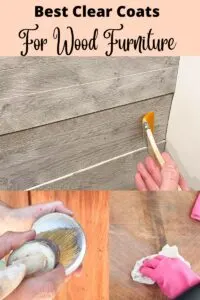
Best Primer for Wood Furniture
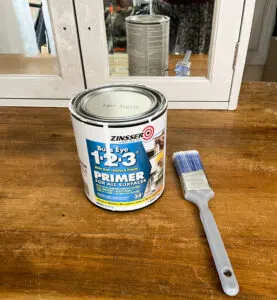
Aesthetics and Finishing
Even though the type of wood plays a huge role in how the furniture piece holds up, it’s also about how the desk is painted, stained and finished. I won’t go into too much detail about the best way to finish a desk (I’ve got a handful of other tutorials that go over this), but I’ll hit some highlights below.
Grain Patterns
Wood species each have unique grain patterns that contribute to the desk’s character. Oak, for example, has a prominent and varied grain pattern, giving it a traditional appearance. In contrast, Maple offers a finer, more uniform grain that suits contemporary styles. This will play a part in how you want to finish the wood. Do you want to enhance the prominent wood grain with a stain product? Or do you want to cover the finer grain with a paint product?
Color Variations
Over time, wood can undergo subtle color changes, deepening or mellowing to create a rich patina. For instance, Cherry wood starts with a light pinkish hue but darkens to a warm, reddish-brown. Walnut, already known for its rich, dark color, may lighten slightly, but generally retains its deep, chocolate tones.
Finish Types
- Oil finishes penetrate the wood, enhancing its natural beauty and offering a warm, tactile feeling.
- Polyurethane coatings provide a harder, more protective surface, available in matte to glossy sheens. This type of top coat sits on top of the surface of the wood and protects it, unlike the oil finishes that penetrate the wood.
- Lacquer finishes, are noted for a smoother appearance and are generally the most durable finish you can apply. Most lacquer products are high gloss.
- Finishes:
- Natural: Enhances the wood’s raw beauty with products like wax
- Stained: Alters color to match decor
- Sealed: Offers protection and shine
Related Posts:
Best Paint for Furniture without Sanding

The BEST Light Wood Stain Colors With Product Examples

Best Colorful Wood Stains for Vibrant and Long-lasting Wood Finishes

Weathered Oak Stain On Pine; Minwax vs. Varathane

Functional Considerations
What about weight limits? Most folks aren’t going to put anything too heavy on a table top, but just so you know, I’ll discuss the weight capacity of a few different hardwood species.
Weight Capacity
Hardwoods like oak and maple offer high weight capacities, suitable for holding heavy equipment. Soft woods like pine wood do not.
- Oak: Can typically support up to 200 pounds.
- Maple: Can typically support around 150 pounds.
Cost Evaluation
How much it costs up front vs. maintenance costs for the wood desk also need to be considered.
Price Range
Hardwoods like oak, maple, and walnut are at the higher end, typically ranging from $20 to $30 per board foot, while softwoods like pine can be more affordable, falling between $5 to $10 per board foot. Exotic options such as teak or mahogany may exceed $40 per board foot, depending on market fluctuations.
Value for Money
Investing in hardwoods like oak or walnut might incur higher initial costs, but over time, they retain their value due to durability and timeless appeal. In contrast, softwoods like pine offer immediate savings but may lack the same lifespan and resale value.
Popular Wood Desk Designs
Traditional Desks
Traditional wood desks often feature classic styling and intricate detailing. They are typically made from hardwoods like oak, cherry, or mahogany due to their durability and rich grain patterns. These desks might include ornate hardware, paneling, and built-in storage options such as drawers and cabinets.
- Oak: Distinguished by its strength and a prominent grain.
- Cherry: Valued for its warm hues and smooth grain.
- Mahogany: Sought after for its durability and reddish-brown color.
You can see below a solid wood antique table with a cherry finish that I stripped and sealed. I still use this desk daily and it’s held up very well over the years.
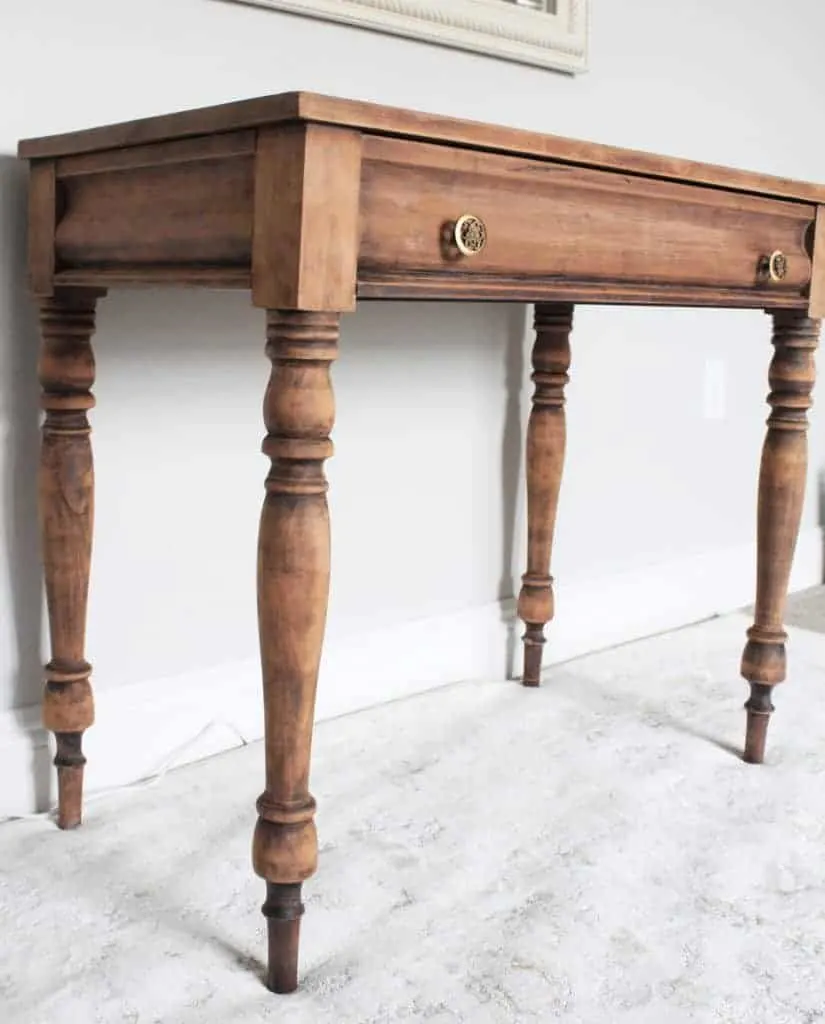
Modern Desks
Modern wood desks embody a contemporary aesthetic with clean lines. They often utilize woods like maple or walnut combined with metal or glass elements. Modern desks prioritize function and form, resulting in sleek surfaces and simple, yet innovative, structures.
- Maple: Known for its light color and subtle grain pattern.
- Walnut: Appreciated for its deep, rich color and fine grain.
Minimalist Desks
Minimalist wood desks strip away excess to focus on simplicity and utility. Often featuring a slender profile, these desks highlight the natural beauty of woods such as birch or ash. They may incorporate straight lines and right angles to emphasize their understated elegance.
- Birch: Light in color with a satiny sheen and fine grain. IKEA uses a lot of birch veneer for their table top furniture. I would consider IKEA to be more of a minimalist or modern design furniture company.
- Ash: Has a light to medium tone with a bold grain pattern.
Although I’m more of a furniture refinisher per se, I have made a few desks over the years. You can see a handful of my DIY desks below.
DIY Vanity Desk Makeover with Attached Medicine Cabinet
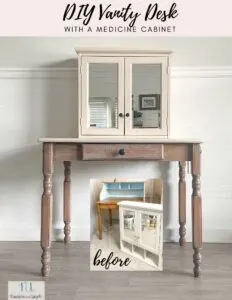
DIY Modern Floating Office Desk with Acacia Butcher Block Countertop

DIY X Sofa Table from Scrap Wood
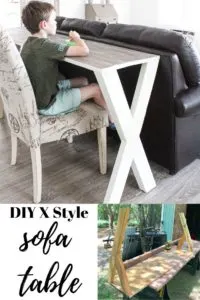
DIY Hairpin Leg Table Anyone Can Create
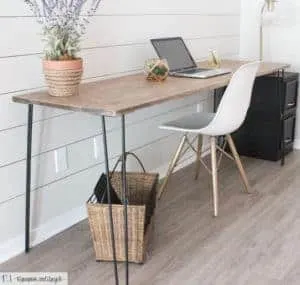
Vintage Casket Carrier Repurposed to a Dining Room Table
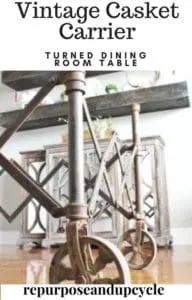
Frequently Asked Questions
What are the benefits of using solid wood versus other materials for desks?
Solid wood is valued for its strength, longevity, and natural beauty. It can be sanded and refinished multiple times, which extends its lifespan compared to materials like particle board or MDF that are less durable and difficult to repair.
How does maple compare to walnut and cherry wood for a quality desk construction?
Maple is a hard, dense wood with a fine, consistent grain, making it resistant to scratches and wear. This makes it ideal for a durable desk surface. Walnut offers a rich, dark color and strong, stable construction. Cherry wood features a warm, reddish hue that deepens with age and is also quite sturdy, though it is softer than maple and walnut.
What wood species are recommended for creating a durable standing desk top?
For a standing desk top, hardwoods such as oak, ash, or hickory are recommended for their strength and resilience to withstand constant adjustments and weight bearing and a long life span.
How important is the thickness of a wooden desk top for its stability and longevity?
The thickness of a wooden desk top is crucial; a thicker top tends to provide greater stability and resistance to warping. Generally, a minimum of 1 inch is recommended for adequate support and longevity of the desk.
Is plywood a viable option for building a sturdy and long-lasting desk?
Plywood can be a practical choice for a desk due to its layered construction that resists warping, it’s cost-effectiveness, and strength. High-grade plywood with a thick veneer can offer both durability and an attractive appearance when properly finished.
A lot of shelving units are made with high grade plywood. You can see some shelves I made for my kitchen here.

Can Oak wood desks withstand the wear and tear from daily gaming activities?
Oak wood is well-suited for gaming desks as it is very durable and can handle heavy usage. Its dense composition can sustain the constant movement and pressure from gaming equipment and frequent use.
Have I answered all the DIY desk wood questions? I sure hope so. As always, drop a note in the comments if you have any more questions.
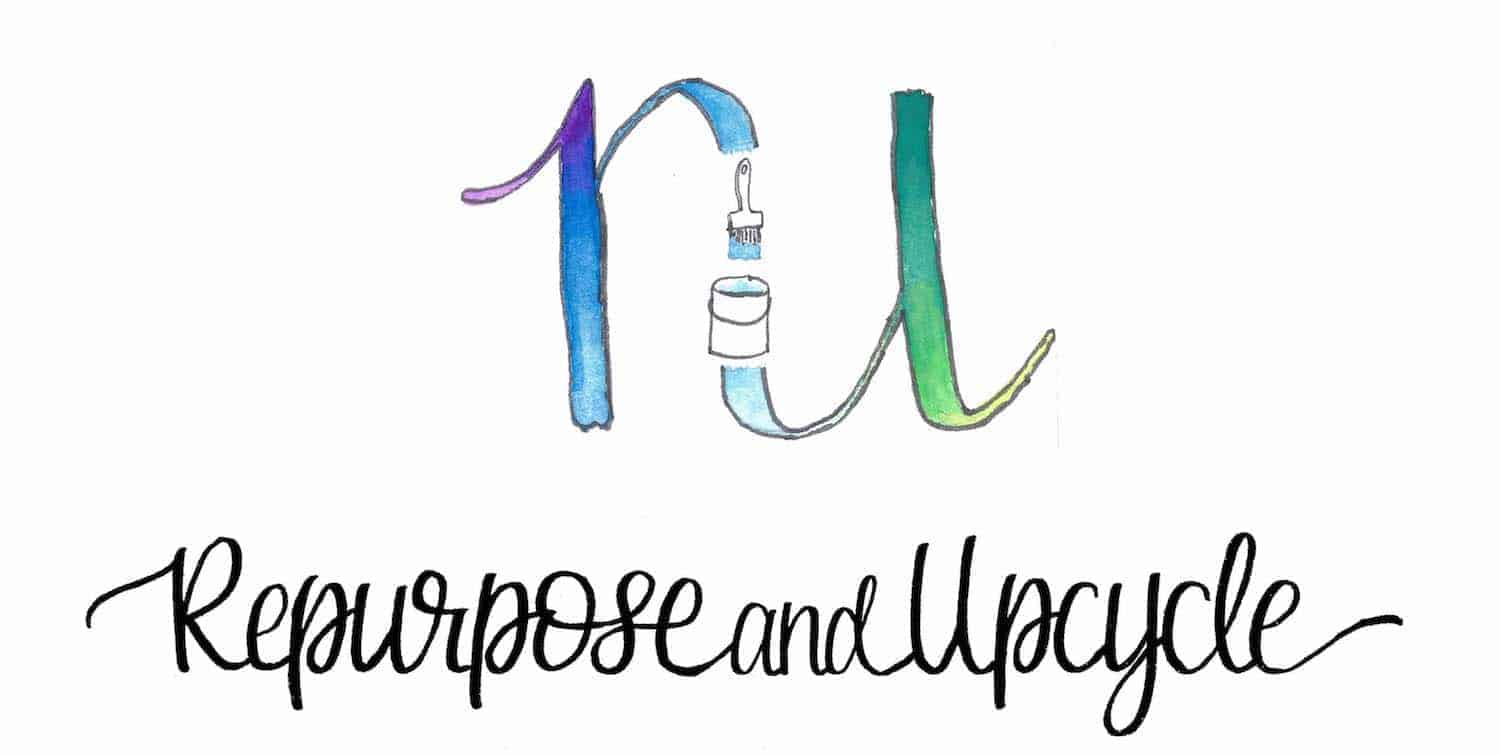
Leave a comment